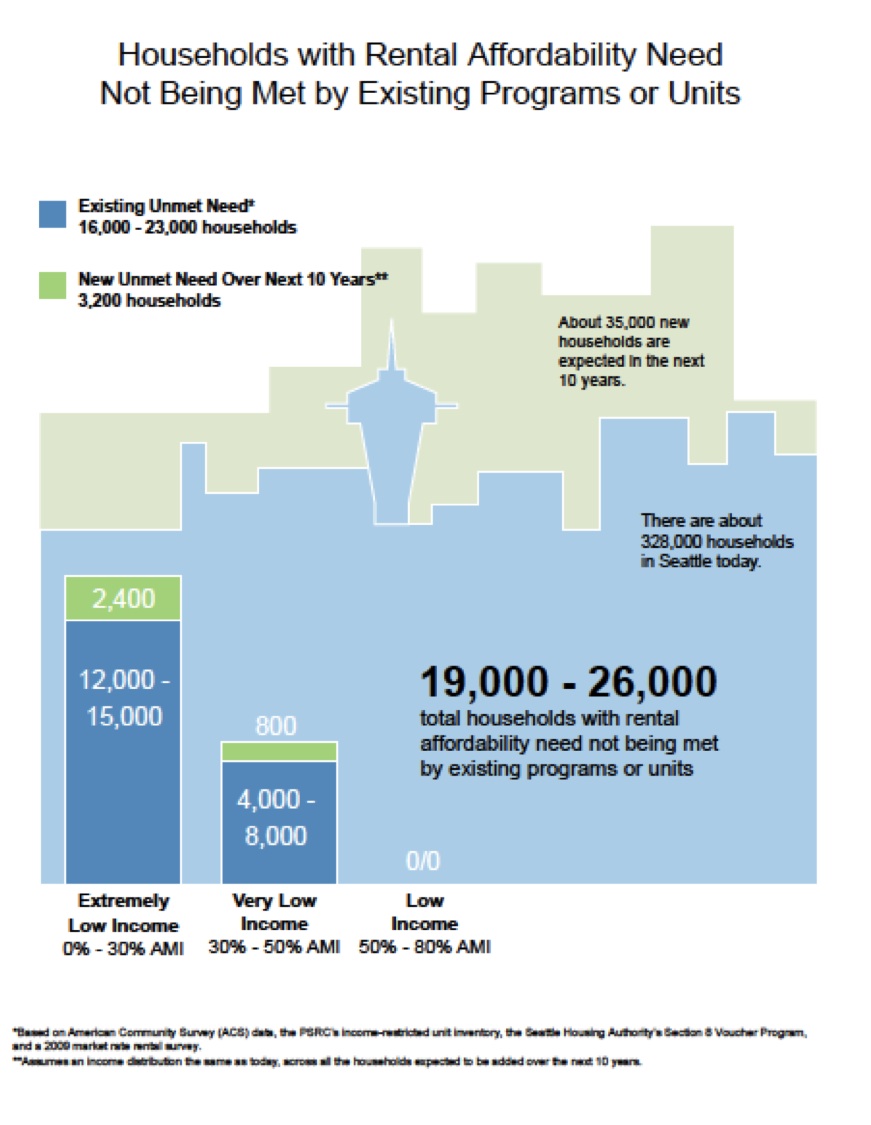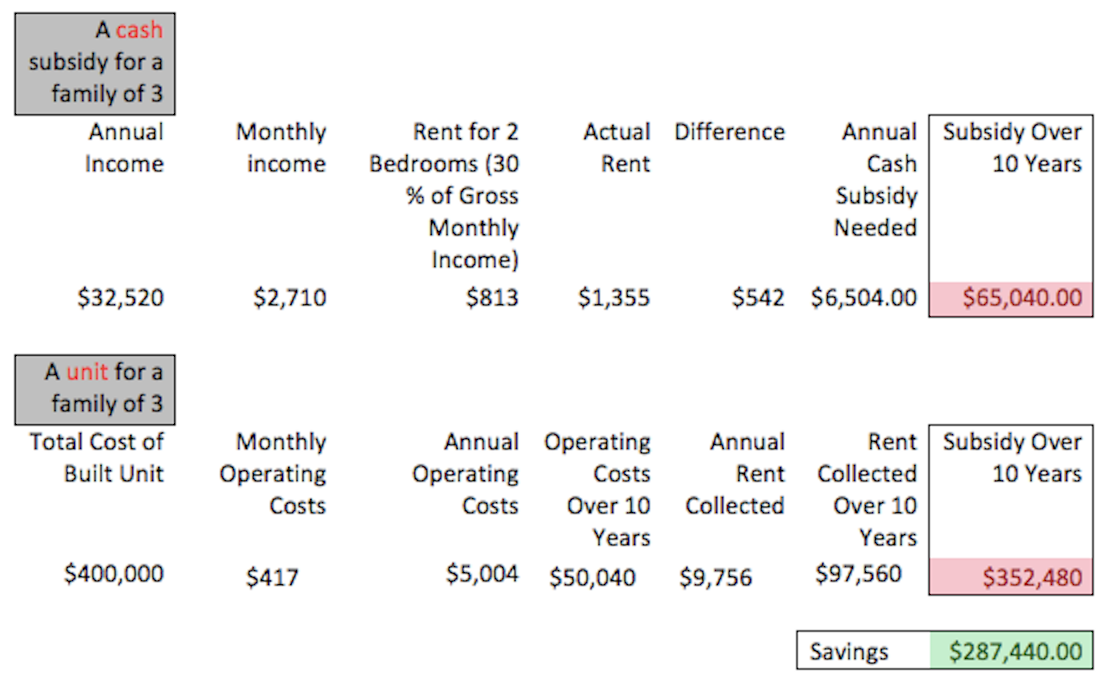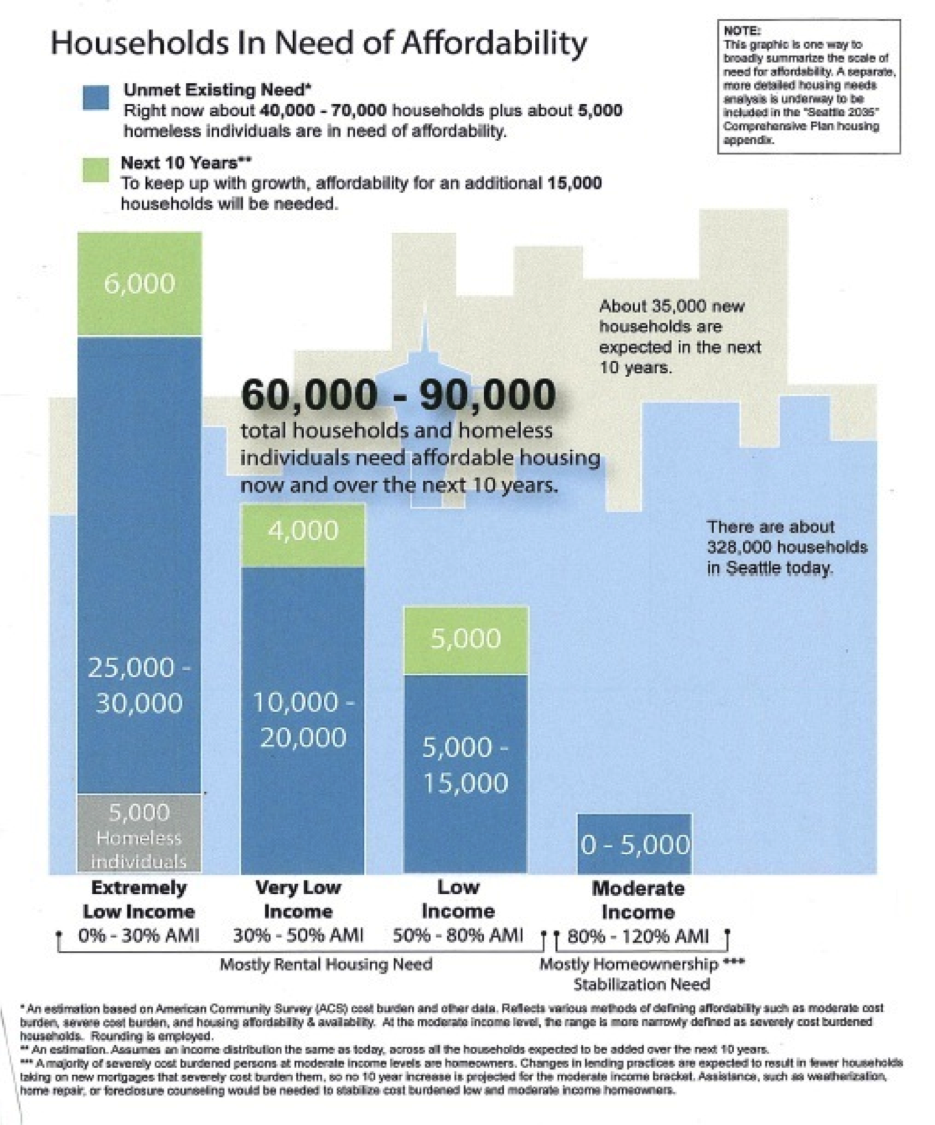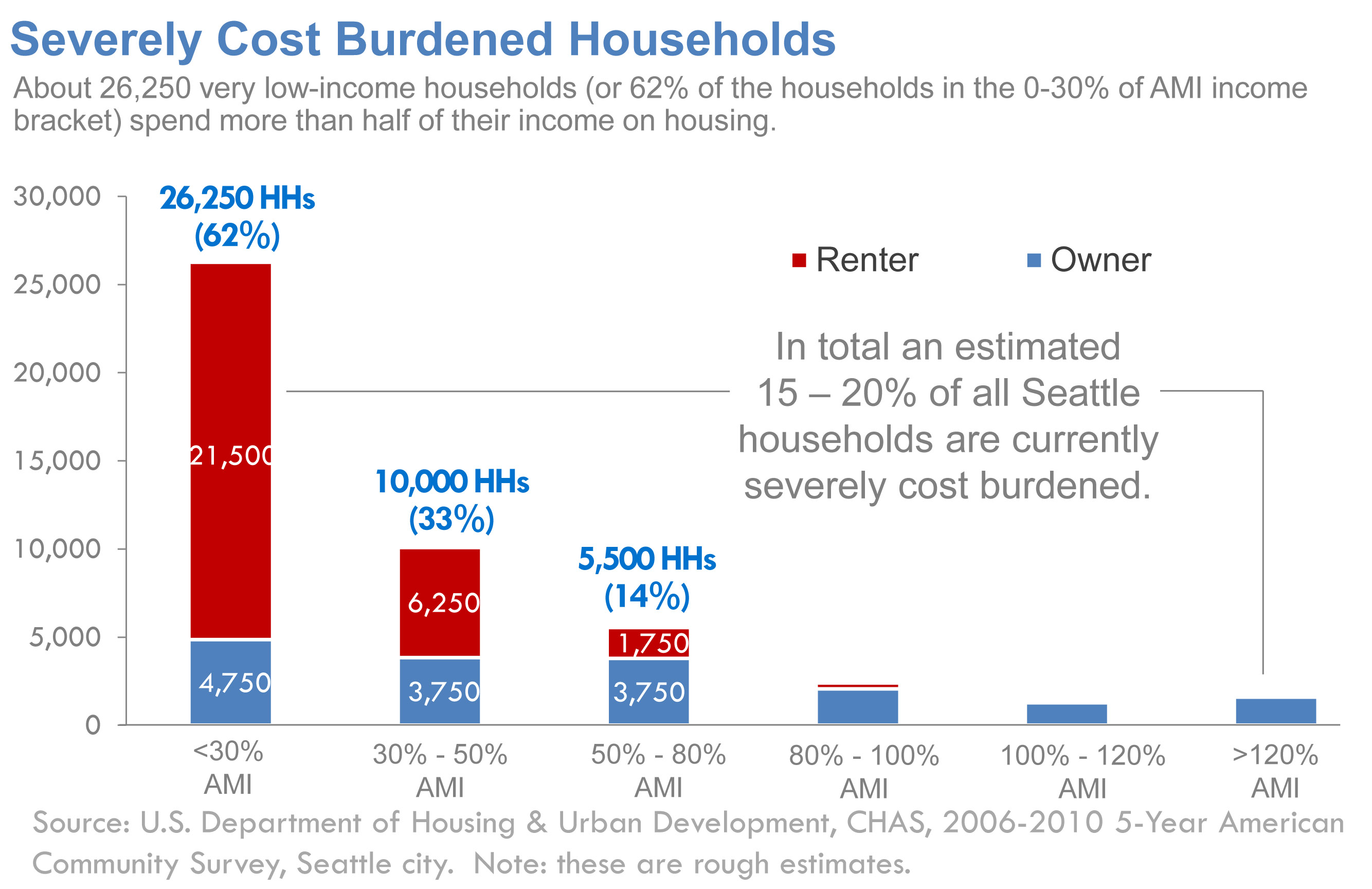Question for Futurewise: Where Do You Stand?
This is a tough e-mail to send, but it appears as though a leader at Futurewise is fighting the basic principles of growth management: density in our cities. We need to hear from Futurewise about where they stand. You can contact their interim ED at Chris@futurewise.org
———————-
Hello Chris and Chuck,
More On Cash Payments for Easing Housing Cost Burden
I have a post at Forbes that takes a look at making cash payments to close the gap between what some families pay for housing and what government bureaucrats say they should pay. According to the Department of Housing and Urban Development, a severely cost burdened household pays 50 percent of its income for housing. I compared the cost of making direct cash payments to one household for 10 years versus building a bricks and mortar unit.
That’s a pretty substantial savings. But that’s just one family, right.
According to the City of Seattle, there are more than 26,000 families that earn between 0 and 30 percent of Area Median Income (AMI) paying 50 percent of their gross monthly income on housing. This number is pretty suspect (what’s 50 percent of $0 in gross monthly income) since we already know that the City failed to account for whether those families are in subsidized housing already, if they have vouchers, or exactly what their circumstances are. When we analyzed the City’s numbers two years ago here’s what we saw happen to the households in need:
Then after we accounted for existing subsidies.
 For example, are we worried about a college student paying 50 percent of her income on housing? Or are we more concerned about a family of three working 4 jobs to make ends meet? The City doesn’t ask such subtle questions of the day, they just uses big round numbers. Here’s their latest chart on cost burdened.
For example, are we worried about a college student paying 50 percent of her income on housing? Or are we more concerned about a family of three working 4 jobs to make ends meet? The City doesn’t ask such subtle questions of the day, they just uses big round numbers. Here’s their latest chart on cost burdened.
So I’ll just make up some numbers too. Based on their assessment what if we gave cash payments to all of those 26,000 plus households assuming that they all are at 30 percent of AMI (of course there is a wide range from exactly 30 to 0 AMI).
Wow. Substantially closing the gap between what all those severely cost burdened houses are paying and what they should be paying would cost $113 million annually. But think about it for a minute. As I’ve said before there were two projects that recently came on line after being in the process for years, the 12th Avenue Arts project on Capitol Hill with a price tag of $47 million for 88 units and the El Centro De la Raza project on Beacon Hill which produced 112 units for $45 million. That’s a total of 200 units for $92 million. And each of these projects has long waiting lists, and they will house families with higher incomes that the 30 percent AMI we’re talking about here.
True, these units will be around for a lot longer than a year, but if we use the rough goess of operating costs that are about $5000 per unit, the cost to keep the units operating is at least $1 million per year. And people have taken issue with my numbers saying only the part of the project that is housing should count in the cost. But I have yet to be told that cost per unit isn’t determined by total project cost. I’m always willing to listen to alternative ways of measuring cost.
It is true that to help even a portion of the households bridge the gap would be an enormous outlay of cash each year. But think about how much money the non-profit system spent building just 200 units. Wouldn’t it make sense to give direct help to a family that is already in a unit, but is finding it hard to stay in that unit. As I point out, the cost would be high, but so is building units. It is also true that the actual number of households that would need the assistance is significantly smaller than the City is claiming. Some combination of these approaches is what we need to be more efficient in how we subsidize housing.
Master Builders Association Leads the Way in Community Building
Anyone who knows me also knows that I’ve been in a lot of arguments and been called many names (I call them sobriquets) because I support and represent developers, builders, and landlords. What bothers me isn’t the name calling (I’m used to it) and the negative energy directed at me (I expect it) but that the negativity exists at all. I know many, many builders in Seattle. Usually, builders are ordinary people just like anyone you’d see standing in line at a coffee shop, with peculiarities and biases and hobbies and family and a job. In the case of people who build housing, that job is usually running their own businesses. Last Thursday just before the snow hit, I attended the 2016 annual gala and officer installation of the Master Builders Association. It was a great event, and incoming President Mike Walsh, owner of Terrene Homes, acknowledged the public perception of builders in his speech.
The first of these [challenges] is our industry image. Most of you know that my company develops land and builds homes. I love my job and believe that what we do makes a difference in people’s lives, but when I attend neighborhood meetings or council meetings or when I listen to the media talking about land development, I hear them portraying builders and developers as though we’re “Rapers and Pillagers.” We provide housing for families, how could that be thought of in any way negative? But somehow the general public sees us as the bad guys.
This is something I’ve been working to reverse for a long time. Why this resentment toward people who build housing” Well, housing is perhaps the biggest single cost people pay each month. And moving and relocating is always a hassle. And there are many people who are struggling to make ends meet, and often those families end up losing their home or facing other housing issues. Then there are all the cranes, and trucks, and noise, and dust, and change that come with growth.
All of these things swirl together and make people who build housing — often the people making the noise and dust — look like the problem. And, imagine this, they make money building housing. I’ve pointed out to people in discussions that what they have at the end of the month after paying bills and covering expenses could hardly be called “profit.” But people angry about change and growth somehow see the benefits from investment or even plain old risk, as ill gotten gains. It is a problem I think that will take lots of time and education to reverse.
But doing things in the community using the unique skills builders have is one really positive way to push back. Since 1993 the Master Builders Association (MBA) has been leading the Rampathon program (the MBA is a major funder of Smart Growth Seattle). From the MBA website:
Rampathon is an annual program of the Master Builders Association where members and volunteers build free wheelchair-access ramps for low-income homeowners throughout King and Snohomish counties. Since its inception in 1993, members and volunteers have built more than 370 ramps contributing to more than 1.7 million dollars of in-kind contributions to our community .
If you watch the video I’ve lead off with, you can see the real benefits builders can bring to bear on real problems. Along with creating better access to their own homes for people, the program provides an educational benefit with a partnership with Sawhorse Revolution. As I’ve said before, imagine if instead of coming after builders with taxes, fees, penalties, rules, and regulations local city governments said, “Hey, can you help us build some housing for people in need?” My guess is, like local hero Mike Huber who received a service award at the event, the answer would be an enthusiastic, “Yes!”
Until programs like Rampathon sink into the popular consciousness, Walsh said clearly we need to advocate for ourselves too.
We must ADVOCATE on behalf of our industry. It’s not enough to complain about bad regulation or politicians after the fact; we need to be in the conversation from the beginning! We need to be the authority on these issues. We need to make our presence felt in all the jurisdictions where we work, to make sure our voice is heard when it comes to new regulations or elected officials. That’s why I ask you to get involved in ADVOCACY.
Very true. And that’s why there is an MBA and a Smart Growth Seattle. The event was inspiring and a great reminder of why we all do what we do, whether it is build housing or mix it up in debates and policy discussions.
Smart Growth Seattle Three Years On: Are We Making Progress?
I wrote a end of year wrap up for the Master Builder Magazine, SGS Three Years On: Are We Making Progress? In considering the positive tone of President Obama’s Housing Development Took Kit I wrote:
The good news: our idea that housing production is not, like many are led to believe, a scourge that needs to be reviewed, taxed, and slowed, but is instead an important community benefit that stands strong on its own, is alive and well. The bad news: even while saying the right things, government still treats what builders of housing do as a negative impact that needs to be offset.
I does feel, three years after starting Smart Growth Seattle, that many of the things I used to say that seemed controversial are now common parlance. The best example of this is the word, supply. As I mentioned in a post, supply is now used with ease among growth supporter and skeptics alike. That’s a win.
In a talk today with the Gallup researcher who wrote a damning criticism of zoning, I pointed out that locally at least, we’re still trying to punish developers, builders, and landlords. His study singled out zoning and regulation as part of the reason places like Seattle don’t have a rational housing market. I said that the lack of rationality starts right at the top with a Mayor and Council dead set on raising prices on new housing to offset rising prices.
It’s going to be an interesting year ahead as we try to build on positive changes in the way people are talking about housing while holding them accountable on what they actually do about it.
Letter to Senator Fain: The High Cost of Affordable Housing
I’ve been writing a bit more at Forbes this last couple weeks. But I thought I’d spark some interest here too on the same theme I’ve been pushing lately on Forbes, the high costs of affordable housing. I’m not sure it’ll get very far, but I’d like to see the legislature take on this issue in 2017. As long as the Mayor and Council want Seattle builders to “pay their fair share,” it seems like we should know what we’re paying for. Right?
Greetings Senator Fain,
- Passing legislation to require a thorough costs study by the State Auditor’s office with help from an independent accounting firm that would compare the costs of producing subsidized housing in our state with market rate housing;
- Requiring a sources and uses funding label for each project in the state built using state funds or tax credits authorized by the WSHFC. This label should be easily accessed and include total project budgets, the sources of funding and a detailed breakdown of categories of spending (eg, hard and soft costs, legal, consultants etc).
- The Commerce Department should be required to produce a plan and recommendations to reduce costs for all housing production based on the completion of the cost study in the legislation (see 1 above)









